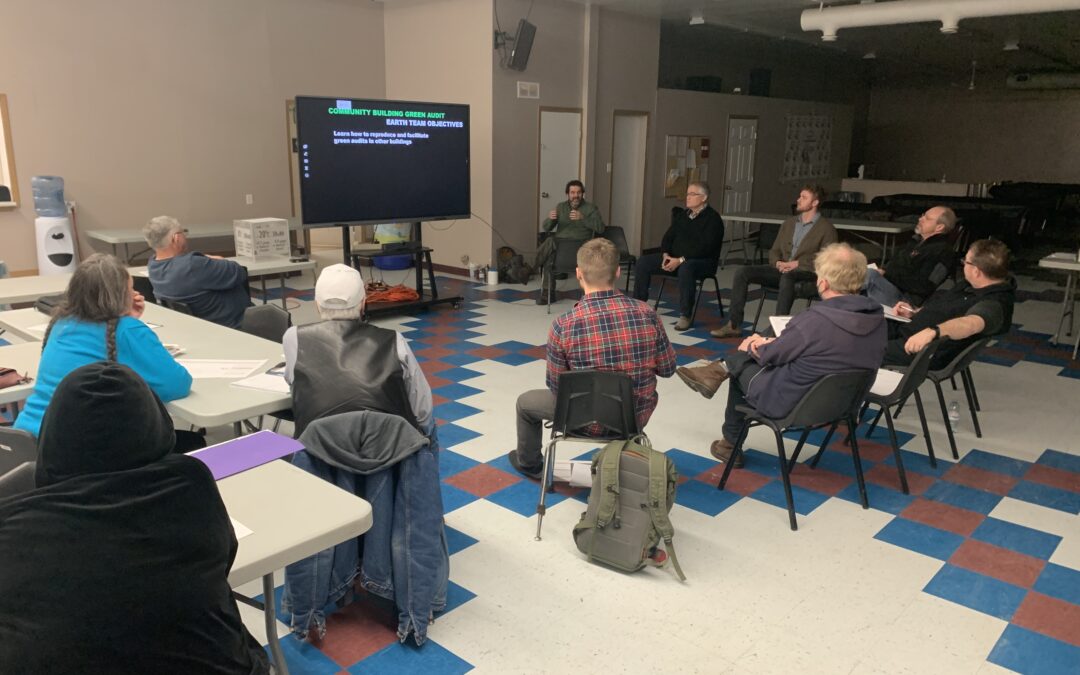By Sean Birkett, Community Building Green Audit Facilitator
This post focuses on the Community for Climate Project through the lens of Swan Lake First Nation. For stories about the other communities involved, click here.
—
Manitoba’s Climate Action Team (CAT) created the Community for Climate Project in 2021. Funded by Environment and Climate Change Canada, the goal is to implement evidence-based strategies for community action in an effort to reduce greenhouse gas emissions. This project works from the grassroots up to support local leadership and implement tangible initiatives, while communicating the urgency and possibility of eliminating fossil fuels as laid out in “Manitoba’s Road to Resilience: A Community Climate Action Pathway to a Fossil Fuel Free Future.”
In the first phase of the project, CAT met with ten communities in Manitoba to discuss climate change mitigation and adaptation in their regions. This included five Indigenous communities and five settler communities.
The second phase, which launched at the beginning of 2023, involves working closely with four of the original ten communities from phase one: Swan Lake First Nation (SLFN), Altona, Brandon, and Sioux Valley Dakota Nation (SVDN). This phase involves the formation of an Earth Team (focused on a Community Building Green Audit) and a Working Group (focused on developing a community led Climate Action Plan), as well as community workshops open to the public.
What does the Community Building Green Audit portion of this phase look like?
- A building from each community is selected to undergo the Community Building Green Audit.
- An Earth Team is created. This is a diverse team made up of 6-12 community members from all walks of life that will be involved with the Community Building Green Audit.
- CAT facilitators perform a building and energy analysis, conduct a waste audit, and gather information on the selected building. The results and information are presented to the Earth Team, who then learn a global to local perspective on the environmental impact of 6 areas: building and energy, transportation, waste, food, water, and green infrastructure. With all this information, the Earth Team comes up with ideas to improve the building’s sustainability within each area and turns these ideas into actions through a process led by CAT facilitators.
- The CAT facilitators assemble all the actions and information into a Community Green Building Audit Action Plan with recommendations for the Earth Team to implement.
- The Earth Team will receive a workbook/guide for them to facilitate future Community Green Building Audits on their own.
In mid-January we had our first Community Building Green Audit meeting with Swan Lake First Nation, and it was a great success. SLFN’s Earth Team is the largest of the four communities – it includes members from the Pembina Valley Watershed District (PVWD), Nellie McClung High School in neighbouring Manitou, as well as members of SLFN.
The meeting started out with a dinner generously provided by the community members of SLFN and allowed the Earth Team and CAT to do introductions in a relaxed, communal setting. Stories and laughter were shared before the group got down to work.
The Earth Team was then posed several questions: ‘What brought you here? Could you tell us of a moment that motivated you to do climate action?’ and ‘What are your expectations from the Community Building Green Audit process we are initiating today?’
Earth Team members wrote down their expectations to be sealed away in a time capsule, only to be opened at the end of phase two
Next, the SLFN Community Hall (the community building of choice), received a thorough building inspection by Mark Ranson, a building science and renovation consultant with over 40 years of experience.
The CAT facilitators delivered a presentation explaining the process and key points of the Community Building Green Audit, at the end of which sparked an engaged discussion and debate on how environmental teaching should be communicated. To be a fly on the wall during this discussion would reveal the motivation and drive held by the SLFN Earth Team.
Finally, the building inspector Mark Ranson delivered a presentation on building science with the objectives of teaching how to save money and reduce emissions, increase the lifespan of buildings, and increase general knowledge of building science.
Jake Goertzen, PVWD board member and Earth Team member says, “A building’s energy efficiency is more and more important considering adapting to climate change and increasing energy costs. The Green Building Audit is something that should be done for all public buildings and as well our houses and workplaces. The science and technology of buildings is changing, and you have to find the sweet spot in balancing the cost of upgrades versus what you are spending on energy.”
At the meeting’s conclusion, CAT and Earth Team members said their goodbyes with their eyes and hearts looking forward to the next meeting of phase two.


